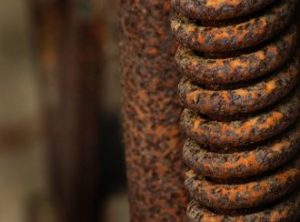It might be time to replace those old torsion springs. Some common applications for torsion springs include: automobiles, agricultural equipment, and construction equipment. It is imperative that springs for machinery are replaced and maintained. Do not neglect old torsion springs. When is the last time you replaced your springs? As these springs age, they become less powerful, exhibiting signs of wear and tear, and can eventually crack or break.
 We’ve come up with a list of five problems you might face with old torsion springs. Are you experiencing any of these problems? If so, it may be time to replace them.
We’ve come up with a list of five problems you might face with old torsion springs. Are you experiencing any of these problems? If so, it may be time to replace them.
Wear and tear
After excessive use, torsion springs will exhibit signs of wear and tear and they will eventually crack or cause damage to the mating part. Once the spring cracks or breaks, you will need to replace it. Avoid sudden problems and costs and replace your old springs before it’s too late. Otherwise you’ll suddenly have to stop what you’re doing and replace a broken spring while your equipment is out of commission. Rather than waiting until they break and having to put everything on hold to fix them, be proactive and replace old torsion springs. If you’re in the agriculture industry, you need durable equipment that will withstand the harsh environments.
Additional damage
An old torsion spring could potentially cause additional damage if it breaks suddenly. If your garage door spring is old, it could suddenly break, resulting in a shockingly loud and abrupt sound, releasing the heavy door quickly. This could cause damage if there is anything in the way of the door when it is suddenly released. This could even harm you if you are standing in the way when this happens. Exercise caution and replace old springs before any damage is caused.
Rust
Torsion springs can accumulate rust over time. If this happens, the lifespan of the spring will be drastically reduced. You might need to replace the spring sooner in this case. The largest cause of spring failures can be account to rust, which is a surface defect. Rust can also cause existing surface defects to become worse, such as nicks or marks.
Poor performance
Over time, torsion springs will lose power and become weaker. Torsion springs work by bending and exerting force. Eventually the spring will weaken, resulting in less powerful force. If you notice a torsion spring is exhibiting less power, it may be time to replace it.
Unreliable
Old torsion springs may not be reliable in harsh weather conditions. Unique materials are often required for those in the agriculture industry to ensure reliable performance in unstable operating environments. Springs can be manufactured in a variety of materials including precious, semi-precious, and standard metals. If you’re dealing with extreme temperatures and extreme pressure loads, we can provide reliable parts that will meet all of your needs.
You might be wondering how long the lifespan for a torsion spring might be. It’s difficult to say how long one of these springs will last. This depends on a number of factors. How often is the spring being used? Under perfect conditions, a standard spring can last millions of cycles. This might seem like a long time to you, but consider how often your farm equipment is used. Plus, it’s unlikely you’re working under perfect conditions. The harsh environment will take a toll. Every time you use that equipment, the spring’s age.
Don’t risk waiting until a torsion spring cracks or breaks. Consider the problems you could face with old torsion springs. Check for rust and take preventative measures to lengthen the lifespan of your torsion springs. Replace old springs when needed.
Belt Tensioner Spring
Learn How We Helped an Automative Parts Manufacturer
Reduce Spring Cost by 20%
